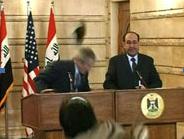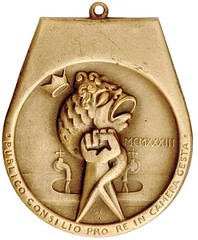
PREV ARTICLE
NEXT ARTICLE
FULL ISSUE
PREV FULL ISSUE
V11 2008 INDEX
E-SYLUM ARCHIVE
IRAQI SHOE-THROWING INCIDENT: SHADES OF THE WASHROOM WARRIOR

This week's shoe-throwing incident in Iraq prompted some numismatists to consider it as
a possible subject for a companion "heroism" medal to go with the Huey Long toilet-seat medal.
-Editor President Bush, on a surprise trip to Iraq and Afghanistan, got a taste of dissent at a Baghdad press event Sunday when an Iraqi journalist threw shoes at him, forcing him to duck.
Barely 24 hours after the journalist, Muntader al-Zaidi, was tackled and arrested for his actions at a Baghdad news conference, the shoe-throwing incident was generating front-page headlines and continuing television news coverage. A thinly veiled glee could be discerned in much of the reporting, especially in the places where anti-American sentiment runs deepest.
In Sadr City, the sprawling Baghdad suburb that has seen some of the most intense fighting between insurgents and American soldiers since the 2003 invasion, thousands of people marched in his defense. In Syria, he was hailed as a hero. In Libya, he was given an award for courage.
In Saudi Arabia, a newspaper reported that a man had offered $10 million to buy just one of what has almost certainly become the world’s most famous pair of black dress shoes.
A daughter of Col. Muammar el-Qaddafi, the Libyan leader, reportedly awarded the shoe thrower, Muntader al-Zaidi, a 29-year-old journalist, a medal of courage.
Barely 24 hours after the journalist, Muntader al-Zaidi, was tackled and arrested for his actions at a Baghdad news conference, the shoe-throwing incident was generating front-page headlines and continuing television news coverage. A thinly veiled glee could be discerned in much of the reporting, especially in the places where anti-American sentiment runs deepest.
In Sadr City, the sprawling Baghdad suburb that has seen some of the most intense fighting between insurgents and American soldiers since the 2003 invasion, thousands of people marched in his defense. In Syria, he was hailed as a hero. In Libya, he was given an award for courage.
In Saudi Arabia, a newspaper reported that a man had offered $10 million to buy just one of what has almost certainly become the world’s most famous pair of black dress shoes.
A daughter of Col. Muammar el-Qaddafi, the Libyan leader, reportedly awarded the shoe thrower, Muntader al-Zaidi, a 29-year-old journalist, a medal of courage.
To read the complete article, see: In Iraqi’s Shoe-Hurling Protest, Arabs Find a Hero. (It’s Not Bush.) (http://www.nytimes.com/2008/12/16/world/middleeast/16shoe.html)
Please, hold your fire on the political commentary. There are indeed some parallels here (and some differences). Regardless, it's an opportunity to discuss one of my favorite medals. The image and text below are taken from the 2006 American Numismatic Rarities sale of the medal from my collection, with recent corrections by Dick Johnson and Dave Bowers.
The parallels are in the political controversy over the incident. Depending on one's political leanings for the victims, the acts can be seen as either heroic or cowardly and rude. The makers of the Washroom Warrior medal (and those heralding the Iraqi shoe-thrower) are in the hero camp. Many others of all political affiliations consider it a disgrace. But if a medal were to indeed be designed and struck to commemorate the incident, it would certainly be an interesting addition to numismatic lore.
One difference is that the Iraqi incident played out in public, in full view of witnesses and television cameras. The Huey Long incident, as described on the medal, was " PUBLIC ACCLAIM / FOR A DEED / DONE IN PRIVATE" -Editor
The parallels are in the political controversy over the incident. Depending on one's political leanings for the victims, the acts can be seen as either heroic or cowardly and rude. The makers of the Washroom Warrior medal (and those heralding the Iraqi shoe-thrower) are in the hero camp. Many others of all political affiliations consider it a disgrace. But if a medal were to indeed be designed and struck to commemorate the incident, it would certainly be an interesting addition to numismatic lore.
One difference is that the Iraqi incident played out in public, in full view of witnesses and television cameras. The Huey Long incident, as described on the medal, was " PUBLIC ACCLAIM / FOR A DEED / DONE IN PRIVATE" -Editor
 This greatly prized satirical medal commemorates an "accident" that befell Senator Huey "Kingfish" Long, easily one of the most corrupt politicians ever spawned.
This greatly prized satirical medal commemorates an "accident" that befell Senator Huey "Kingfish" Long, easily one of the most corrupt politicians ever spawned. It seems that on August 26, 1933 in Sands Point, Long Island, Long stumbled out of the men's room in a local establishment, his nose bloodied and his head dripping wet; he said he was attacked by a group of men, yet he was the only one in the washroom by the time his supporters entered and looked around.
Local legend has it that he was simply punched square in the face by an irate citizen of Louisiana, then forcibly dragged across the floor to have his head ceremoniously dunked in a porcelain plumbing receptacle. Commissioned by an unknown New York lawyer and designed by caricaturist George De Zayas (1894-1967), the original gold medal was struck by Medallic Art Company and given to the ANS in New York City to be presented to the actual perpetrator. He never showed to claim his gold medal; it has remained unclaimed for 75 years! Medallic Art also struck bronze replicas from the same dies.
Curiously, the U.S. Senate actually took up a collection to try to suppress this broadside at one of their own fine compatriots. More on this amusing incident in American political history can be read in The Numismatist, November 1933, pp. 704-705, and in Coins Magazine, November 1963, pg. 31.
Dave Bowers forwarded the following text from the Whitman 100 Greatest Tokens and medals book, which he coauthored with Katie Jaeger.
No. 140 • 1933 Huey Long Toilet Seat Medal • One of the most improbable subjects ever rendered on a medal, by the Medallic Art Co., no less. But, then, Huey Long, known as the “Kingfish” with his one-man rule of Louisiana politics, was a rather improbable politician. Had he not been assassinated in 1935, American political history would likely be different from what we know today. This satirical medal commemorates a set-to when Long left a rest room in Sands Point, Long Island (New York), August 28, 1933, and was set upon by a concerned citizen (accounts as to what happened varied widely; Time magazine reported that a drunk Long had urinated on the trousers of the citizen), the shape of a convenient rest room facility defining the outline of this medal.
To read the earlier E-Sylum article on the topic, see: FEATURED WEB PAGE: 1933 HUEY LONG WASHROOM WARRIOR MEDAL http://www.coinbooks.org/esylum_v11n02a21.html
THE BOOK BAZARRE
Wayne Homren, Editor
The Numismatic Bibliomania Society is a non-profit organization promoting numismatic literature. See our web site at coinbooks.org.
To submit items for publication in The E-Sylum, write to the Editor at this address: whomren@gmail.com
To subscribe go to: https://my.binhost.com/lists/listinfo/esylum
All Rights Reserved.
NBS Home Page
Contact the NBS webmaster
